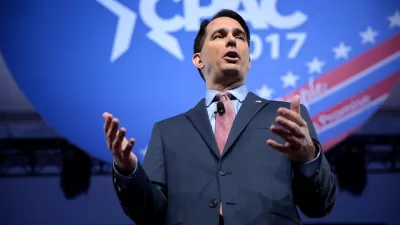Ozone pollution is worsening in five counties in Southern California, and the Air Quality Management District doesn't know why.

"Southern California's ozone pollution has worsened over the last two years, even as regulators say emissions are declining," reports Tony Barboza, who covers air quality and the environment with a focus on Southern California for the Los Angeles Times, on Nov. 15.
Ozone, the harmful gas in smog that inflames the lungs and triggers asthma attacks and other health problems, has violated federal health standards 145 days this year across Los Angeles, Orange, Riverside and San Bernardino counties, air monitoring data show. That’s up from 132 ozone violation days last year and 113 in 2015.
The South Coast Air Quality Management District, which regulates air quality in most of the four-county region, points to hotter temperature and inversions which trap pollution close to the ground. Public health and environmental groups disagree, questioning whether the emissions reductions estimates are accurate, and wanting the district to get tougher on stationary source emitters, like power plants and refineries.
Emissions dropping
Air quality officials say their projections show emissions of smog-forming pollutants continue dropping dramatically. And as mandates for cleaner cars and trucks continue to kick in, they expect ozone levels to decline over the long term.
Is climate change to blame?
Regulators and scientists say it is too soon to say whether climate change is driving recent increases in California smog. Researchers predict global warming will complicate efforts to clean air pollution by increasing the number of hot days, which speed up the photochemical reactions that generate ozone. But a few years of data is not enough to detect the fingerprints of global warming, they say
Ozone pollution difficult to regulate
Unlike other forms of air pollution, ozone, or smog, is formed in the lower atmosphere in the presence of heat and sunlight. Reducing ozone means reducing emissions of the two main contributors, nitrogen oxides (NOx) and volatile organic compounds.
Cut them in the wrong proportion and you may see no ozone reduction at all or even an increase, said Michael Kleeman, professor of civil and environmental engineering at UC Davis.
At the same time, both the quantity and intensity of heat and sunlight exacerbate ozone formation, so there are lots of variables to consider.
Transformation of transportation sector
Regulators say cleaning the air to federal standards will require a massive transformation of California’s transportation sector, which releases most of the state’s pollution. Gas and diesel engines must be replaced with zero- and near-zero-emission battery electric and hydrogen fuel cell engines and other emerging technologies.
That's fodder for Assemblyman Phil Ting (D-San Francisco) who plans to introduce legislation in February to ban sales of passenger vehicles powered by gasoline and diesel fuel by 2040.
The region's largest source of emissions, the ports of Los Angeles and Long Beach, are headed in that direction with the adoption of the Clean Air Action Plan (pdf) earlier this month. It encourages "the phase-out of diesel trucks in favor of natural gas and, ultimately, zero-emissions trucks and cargo-handling equipment over the next two decades," reported Barboza on Nov. 2.
Projections show most of the 17,000 trucks serving the ports becoming near-zero, or natural gas-fueled, by 2024. Zero-emissions trucks would become the majority by 2036.
FULL STORY: Southern California smog worsens for second straight year despite reduced emissions

Planetizen Federal Action Tracker
A weekly monitor of how Trump’s orders and actions are impacting planners and planning in America.

San Francisco's School District Spent $105M To Build Affordable Housing for Teachers — And That's Just the Beginning
SFUSD joins a growing list of school districts using their land holdings to address housing affordability challenges faced by their own employees.

The Tiny, Adorable $7,000 Car Turning Japan Onto EVs
The single seat Mibot charges from a regular plug as quickly as an iPad, and is about half the price of an average EV.

With Protected Lanes, 460% More People Commute by Bike
For those needing more ammo, more data proving what we already knew is here.

In More Metros Than You’d Think, Suburbs are Now More Expensive Than the City
If you're moving to the burbs to save on square footage, data shows you should think again.

The States Losing Rural Delivery Rooms at an Alarming Pace
In some states, as few as 9% of rural hospitals still deliver babies. As a result, rising pre-term births, no adequate pre-term care and "harrowing" close calls are a growing reality.
Urban Design for Planners 1: Software Tools
This six-course series explores essential urban design concepts using open source software and equips planners with the tools they need to participate fully in the urban design process.
Planning for Universal Design
Learn the tools for implementing Universal Design in planning regulations.
Smith Gee Studio
City of Charlotte
City of Camden Redevelopment Agency
City of Astoria
Transportation Research & Education Center (TREC) at Portland State University
US High Speed Rail Association
City of Camden Redevelopment Agency
Municipality of Princeton (NJ)




























